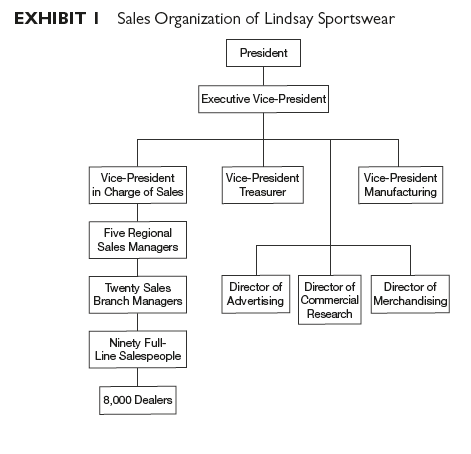Although the current sales organization of Lindsay Sportswear had been effective for a number of years, recent changes in the marketing and distribution of sportswear, as well as changes in Lindsay policies and practices, indicated that a revision of the present sales organization was required. Arthur Lindsay, president of Lindsay Sportswear, was concerned with the apparent inability of Jim Frankfort’s sales force to handle the various tasks assigned to it. His son, Arthur, Jr., who was registered in an MBA program at Dartmouth, suggested that a reorganization of marketing responsibilities in the firm might solve the problem. He explained that a vice-president of marketing could coordinate merthan- dis-ing, advertising, and selling activities. He also suggested that product managers would ensure that each product got a fair share of the time of the sales force.
Lindsay Sportswear manufactured a wide line of men’s and boys’ sportswear, including sweaters, hunting coats, caps, gloves, sport coats, slacks, sport shirts, jackets, swimwear, walking shorts, and socks. Annual sales of $125 million attested to the wide consumer acceptance of the “Lindsay Sportswear” brand. The sportswear was distributed directly to 8,000 men’s and boys’ shops and department stores. As Lindsay sales increased over the years, the sales organization evolved from a simple line type into a more complex organization, as shown in Exhibit 1.
The vice-president of sales was responsible for the administration of the. sales department and was concerned with organizing, planning, directing, coordinating, and appraising the total sales operation. Regional sales managers were responsible for sales in their territories, field supervision of the branch sales offices, and implementing the sales policies. The sales branch managers spent the majority of their time in the field with the sales force. Ninety full-line salespersons operated out of twenty sales branch offices.
The directors of advertising, commercial research, and merchandising reported to the executive vice-president, as did the sales vice-president. The advertising director administered the $4,000,000 annual advertising appropriation and, in consultation with the sales vice-president, prepared the advertising budget and examined and approved all work done by the advertising agency. The commercial research director planned and conducted surveys for the sales vice-president as well as for other department heads. Surveys measuring the market potential for sportswear, the prefer-ences of buyers, the frequency of purchase, the attitudes of dealers, and the like were used in establishing sales policies and strategies, setting sales quotas, determining sales territories, selecting dealers, and evaluating sales performances.

The merchandising director was responsible for coordination of manufacturing and sales, by taking demand preferences on the one hand and manufacturing costs on the other and working out a plan that balanced the two. His main function was to determine garment design and specifications and to make sure that dealers and consumers got what they wanted without building up excessive inventory.
One development that signaled a need for possible change in the sales organization was that sales of boys’ sportswear had more than doubled due to a number of factors such as an increase in the number of individual children’s shops and the growing interest of men’s wear retailers in boys’ wear. Thus, boys’ sportswear became the largest seller in the Lindsay Sportswear line, a great change from just five years ago. One effect of the boys’ wear sales increase was that Lindsay Sportswear sales personnel were devoting most of their efforts to the easier-to-sell boys’ wear line, at the expense of the men’s wear line.
Greater dealer and consumer interest in the color, style, and fabrics of men’s sportswear made it necessary to give closer consideration to buyers’ tastes and preferences. The salespeople, by virtue of being closest to the market, were in a position to suggest garment-style preferences to the merchandising department. One Lindsay salesperson suggested to the merchandising director that a panel of famous personalities be established as style consultants from which would come sportswear ideas the panel considered to be most fashionable. The initial panel consisted of several famous golfers. The sales of the sportswear selected by the style consultants were good enough to warrant investigation of a possible change in the Lindsay Sportswear sales organization that would permit closer cooperation between the merchandising staff and the sales department.
As the Lindsay line expanded, it became apparent that the ninety full-line salespeople were spending so much time introducing new seasonal lines and promotions that they were unable to serve dealers properly. Much important service work by salespersons was being neglected, such as assistance in stock control, pricing, point-of-purchase display, and training retail salesclerks. Neglect of dealer service duties resulted in the loss of some major accounts, who switched to competing lines of men’s sportswear.
The sales manager, Jim Frankfort, argued that the current organizational structure reflected correct priorities because personal selling was the really important factor in the success of the Lindsay company. Sales were dependent on the strength and cooperation of retail outlets, and it was the sales force that achieved the cooperation of the retailers. His proposed solution to correct criticisms, therefore, was that the sales department be reorganized to solve three problems: (1) neglect of the full line of sportswear by salespeople who spent most of their sales attention on the fast-selling boys’ wear, (2) the need to improve styling of the line by the merchandising department through closer cooperation with the sales department, and (3) neglect of dealer service by the sales force.
Source: Richard R. Still, Edward W. Cundliff, Normal A. P Govoni, Sandeep Puri (2017), Sales and Distribution Management: Decisions, Strategies, and Cases, Pearson; Sixth edition.

Thanks for sharing your info. I really appreciate your efforts and
I am waiting for your next post thank you once again.
Saved as a favorite, I love your site!
I am truly pleased to read this website posts which consists of tons of helpful data, thanks for providing such information.